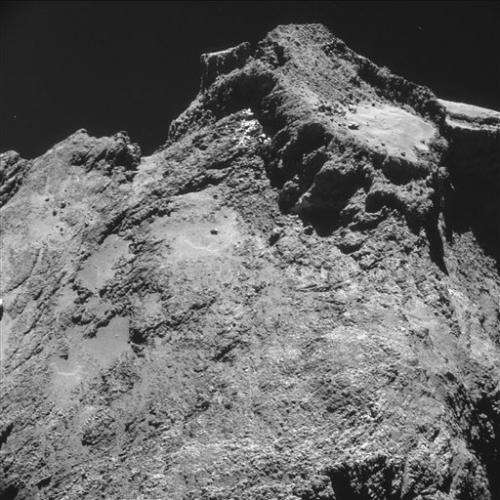Comet lander may not be securely anchored: ESA

A European probe Wednesday made the first-ever landing on a comet in a quest to explore the origins of the Solar System, but there were concerns over whether it was fastened securely enough to carry out its mission.
The European Space Agency (ESA) said the robot lab, called Philae, had touched down on the comet 67P/Churyumov-Gerasimenko in a high-risk manoeuvre more than 510 million kilometres (320 million miles) from Earth.
"Philae is talking to us," said Stephan Ulamec, the lander's manager said at the end of the lander's seven-hour descent from its orbiting mothership. "We are on the comet."
But the announcement was soon followed by worries that Philae may have landed in soft material and was not properly attached.
The 100-kilo (220-pound) lander separated from its mother ship, Rosetta, after a trek lasting a decade and covering 6.5 billion kilometres (four billion miles).
At the ESA's operations centre in Darmstadt, Germany, a crowd of scientists, guests and VIPs—including the two Ukrainian astronomers who first spotted the comet in 1969—cheered at the announcement of the landing, the centrepiece of one of the riskiest projects in space exploration.
"This is a big step for human civilisation," said the agency's director general, Jean-Jacques Dordain.
"Our ambitious Rosetta mission has secured another place in the history books," he said. "Not only is it the first to rendezvous with and orbit a comet, but it is now also the first to deliver a probe to a comet's surface."
Scientists hope the lander, equipped with 10 instruments, will unlock the secrets of comets—primordial clusters of ice and dust that may have helped sow life on Earth.
Getting from Earth to a comet that is travelling towards the Sun at 18 km per second was a landmark in space engineering and celestial mathematics.
The 1.3-billion-euro ($1.6-billion) Rosetta mission was approved in 1993.
Rosetta, carrying Philae, was hoisted into space in 2004, and took more than a decade to reach its target, which it did in August this year, having used the gravitational pull of Earth and Mars as slingshots to build up speed.
Philae was designed to settle down at a gentle 3.5 km per hour, firing two harpoons into the hope that the comet surface—a complete unknown—would give it grip.
Ice screws at the end of its three legs were then to drive into the low-gravity comet to stop the probe bouncing back into space.
In a final health check before separation, a problem was detected with the small thruster on top of Philae that was designed to counteract the recoil.
And after landing, questions arose whether the craft was secured.
"There are some indications that they (the harpoons) might not have been fired, which could mean that we are sitting in soft material and we are not anchored," said Ulamec.
"We have to analyse what is the actual situation."
Two decades
Rosetta stands as a landmark mission in space, both for its complexity and length.
Turning slowly around "67P" since August, the spacecraft has made some astonishing observations.
The comet's profile somewhat resembles that of a rubber bath duck, but darker than the blackest coal, and with a surface gnarled and battered by billions of years in space: an extremely difficult target to land on.
Philae's work programme includes drilling into the surface of comet "67P" and analysing the sample for telltale isotopes in water and complex carbon molecules.
It has enough battery power to provide about 60 hours of work, but can continue until March with a solar recharge.
It accounts for about a fifth of the mission's total expected data haul from the marathon mission.
Rosetta will continue to escort the comet, scanning it with 11 instruments, as it loops around the Sun and makes its closest approach next year.
According to a leading theory, comets pounded the fledgling Earth 4.6 billion years ago, providing it with carbon molecules and precious water—part of the tool kit for life.
© 2014 AFP




















